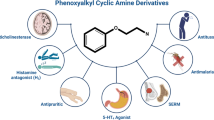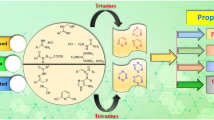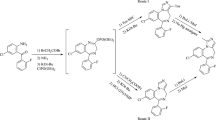Abstract
A collection of structurally complex and chemically diverse small molecules is a useful tool to explore cell circuitry. In this article, we have reported the two step synthesis of diverse spirooxindoles. The key reaction to assemble the spirooxindole core is a Lewis acid catalyzed three component coupling. The final library of compounds was then analyzed for their cytotoxic activity against U87 human glioma cells. It is noteworthy to mention that this is the first report on the pharmaceutical evaluation of such compounds. Although the activity is moderate, it opens the door for new chemical modifications of spirooxindoles.
Graphical abstract





Similar content being viewed by others
References
Bonsignore L, Loy G, Secci D, Calignano A (1993) Synthesis and pharmacological activity of 2-oxo(2H)1-benzopyran-3-carboxamide derivatives. Eur J Med Chem 28:517–520
Chandrasekhar S, Narsihmulu C, Sultana SS, Reddy NR (2002) Poly(ethylene glycol) (PEG) as a reusable solvent medium for organic synthesis. Application in the Heck reaction. Org Lett 4:4399. doi:10.1021/ol0266976
Cornils B, Herrmann WA (1998) Aqueous phase organometallic catalysis—concepts and applications. Wiley-VCH, Weinheim
Cui CB, Kakeya H, Osada H (1996a) Spirotryprostatin B, a novel mammalian cell cycle inhibitor produced by Aspergillus fumigatus. J Antibiot 49:832
Cui CB, Kakeya H, Osada H (1996b) Novel mammalian cell cycle inhibitors, tryprostatins A, B and other diketopiperazines produced by Aspergillus fumigatus. II. Physico-chemical properties and structures. J Antibiot 49:534–540
DeSimone RW, Mitchell KS, Currie SA, Darrow JW, Pippin DA (2004) Privileged structures: applications in drug discovery. Comb Chem High Throughput Screen 7:473–493
Elguero J, Goya P, Jagerovic N, Silva AMS (2002) Pyrazoles as drugs: facts and fantasies. Targets Heterocycl Syst 6:52–98
Evans BE, Rittle KE, Bock MG, DiPardo RM, Freidinger RM, Whitter WL, Lundell GF, Veber DF, Anderson PS, Chang RSL, Lotti VJ, Cerino DJ, Chen TB, Kling PJ, Kunkel KA, Springer JP, Hirshfield J (1988) Methods for drug discovery: development of potent, selective, orally effective cholecystokinin antagonists. J Med Chem 31:2235–2246
Galliford CV, Scheidt KA (2007) Pyrrolidinyl-spirooxindole natural products as inspiration for the development of potential therapeutic agents. Angew Chem Int Ed 46:8748. doi:10.1002/anie.200701342
Haimov A, Neumann R (2002) Polyethylene glycol as a non-ionic liquid solvent for polyoxometalate catalyzed aerobic oxidation. Chem Commun 21:876–877. doi:10.1039/b200559j
Hansch C, Steward AR, Iwasa J, Deutsh EW (1965) The use of a hydrophobic bonding constant for structure–activity correlations. Mol Pharmacol 1:207. doi:10.1124/mol.1.3.205
Jain SC, Kumar R, Goswami R, Pandey MK, Khurana S, Rohtagi L, Gyanda K (2005) Synthesis of novel non-isoprenoid phenolic acids and 3-alkylpyridines. Pure Appl Chem 77:185–193. doi:10.1351/pac200577010185
Joshi KC, Jain R, Sharma K (1988) J Indian Chem Soc 115:202
Kang T-H, Matsumoto K, Murakami Y, Takayama H, Kitajima M, Aimi N, Watanabe H (2002) Pteropodine and isopteropodine positively modulate the function of rat muscarinic M(1) and 5-HT(2) receptors expressed in Xenopus oocyte. Eur J Pharmacol 444:39–45
Kauzmann W (1959) Some factors in the interpretation of protein denaturation. Adv Protein Chem 14:37
Kidwai M, Jain A, Bhardwaj S (2012a) Magnetic nanoparticles catalyzed synthesis of diverse N-heterocycles. Mol Divers 16:121–128. doi:10.1007/s11030-011-9336-z
Kidwai M, Jain A, Sharma A, Kuhad RC (2012b) First time reported enzymatic synthesis of new series of quinoxalines—A green approach. J Mol Catal B Enzym 74:236–240. doi:10.1016/j.molcatb.2011.11.002
Konkoy CS, Fick DB, Cai SX, Lan NC, Keana JFW (2000) PCT Int. Appl.WO0075123. Chem Abstr 2001(134):29313a
Kubo I, Muroi H, Himejima M (1993) Structure–antibacterial activity relationships of anarcadic acids. J Agric Food Chem 41:1016–1019
Kulkarni SK, Kaul PN (1980) Substances of marine origin affecting pentobarbital pharmacokinetics. Indian J Exp Biol 13:270–272
Leitner W (2002) Supercritical carbon dioxide as a green reaction medium for catalysis. Acc Chem Res 35:746–756. doi:10.1021/ar010070q
Marina O, Shibinskaya SA, Lyakhov AV, Mazepa SA, Andronati AV, Turov NM, Zholobak NYS (2010) Synthesis, cytotoxicity, antiviral activity and interferon inducing ability of 6-(2-aminoethyl)-6H-indolo[2,3-b]quinoxalines. Eur J Med Chem 45:1237–1243. doi:10.1016/j.ejmech.2009.12.014
Nandakumar A, Thirumurugan P, Perumal PT, Vembu P, Ponnuswamy MN, Ramesh P (2010) One-pot multicomponent synthesis and anti-microbial evaluation of 2′-(indol-3-yl)-2-oxospiro(indoline-3,4′-pyran) derivatives. Bioorg Med Chem Lett 20:4252–4258. doi:10.1016/j.bmcl.2010.05.025
Patchett AA, Nargund RP (2000) Section IV. Topics in drug design and discovery. Annu Rep Med Chem 35:289–298. doi:0065-7743/00
Penning TD, Talley JJ, Bertanshaw SR, Carter JS, Collins PW, Docter S, Graneto MJ, Lee IF, Malecha JW, Miyashiro JM, Roger RS, Rogier DJ, Yu SS, Anderson GD, Burton EG, Cogburn JN, Gregory SA, Koboldt CM, Perkins EW, Seibert K, Veenbuizen AW, Zhang YY, Isakson PC (1997) Synthesis and biological evaluation of the 1,5-diarylpyrazole class of cyclooxygenase-2 inhibitors: identification of 4-[5-(4-methylphenyl)-3-(trifluoromethyl)-1H-pyrazol-1-yl]benzenesulfonamide (SC-58635, celecoxib). J Med Chem 40:1347–1365
Rahman A, Silva WSJ, Alvi KA, De Silva KTD (1987) Nb-demethylalstophylline oxindole, an oxindole alkaloid from the leaves of Alstonia macrophylla. Phytochemistry 26:865
Schreiber SL (2000) Target-oriented and diversity-oriented organic synthesis discovery. Science 287:1964–1969. doi:10.1126/science.287.5460.1964
Sheldon RA (2001) Catalytic reactions in ionic liquids. Chem Commun 23:2399–2407. doi:10.1039/B107270F
Sheldon RA (2005) Green solvents for sustainable organic synthesis: state of the art. Green Chem 7:267. doi:10.1039/b418069k
Skommer J, Wlodkowic D, M€att€o M, Eray M, Pelkonen J (2006) HA14-1, a small molecule Bcl-2 antagonist, induces apoptosis and modulates action of selected anticancer drugs in follicular lymphoma B cells. Leuk Res 30:322–331
Togo H, Lida S (2006) Synthetic use of molecular iodine for organic synthesis. Synlett 14:2159–2176. doi:10.1055/s-2006-950405
Wang X, Quan Z, Zhang Z (2007) Michael additions of dihydropyrimidines and 2-amino-1,3,4-thiadiazoles to a,b-ethylenic compounds: using polyethylene glycols as a green reaction media. Tetrahedron 63:8227–8233. doi:10.1016/j.tet.2007.05.108
Williams RM, Cox RJ (2003) Paraherquamides, brevianamides, and asperparalines: laboratory synthesis and biosynthesis. An interim report. Acc Chem Res 36:127–139. doi:10.1021/ar020229e
Yanagida S, Takahashi K, Okahama M (1978) Metal-ion complexation of noncyclic poly(oxyethylene) derivatives. II. PMR studies of the complexation with alkali and alkaline earth metal cations. Bull Chem Soc Jpn 51:1294–1299
Acknowledgments
Author (A. Jain) is thankful to UGC for providing senior research fellowship. M. Kidwai is grateful to the University of Delhi for providing financial assistance.
Author information
Authors and Affiliations
Corresponding author
Electronic supplementary material
Below is the link to the electronic supplementary material.
Rights and permissions
About this article
Cite this article
Kidwai, M., Jain, A., Nemaysh, V. et al. Efficient entry to diversely functionalized spirooxindoles from isatin and their biological activity. Med Chem Res 22, 2717–2723 (2013). https://doi.org/10.1007/s00044-012-0249-x
Received:
Accepted:
Published:
Issue Date:
DOI: https://doi.org/10.1007/s00044-012-0249-x




